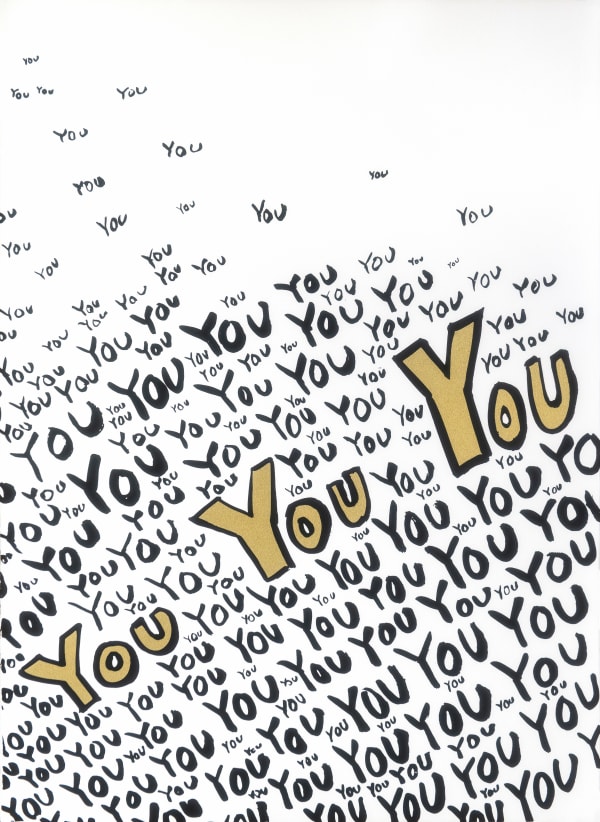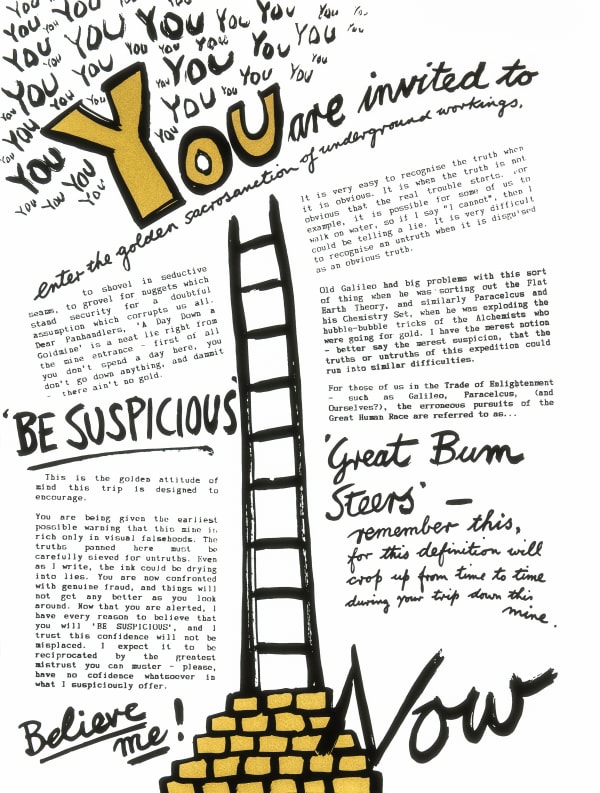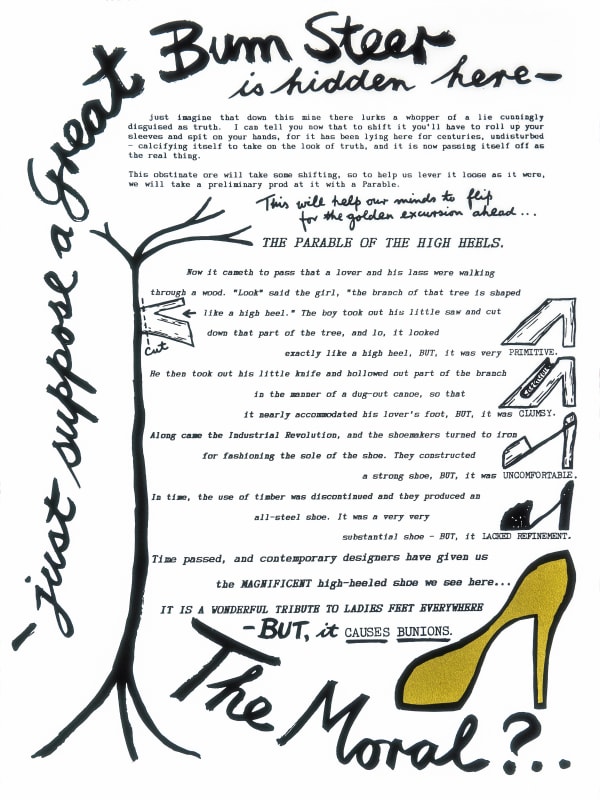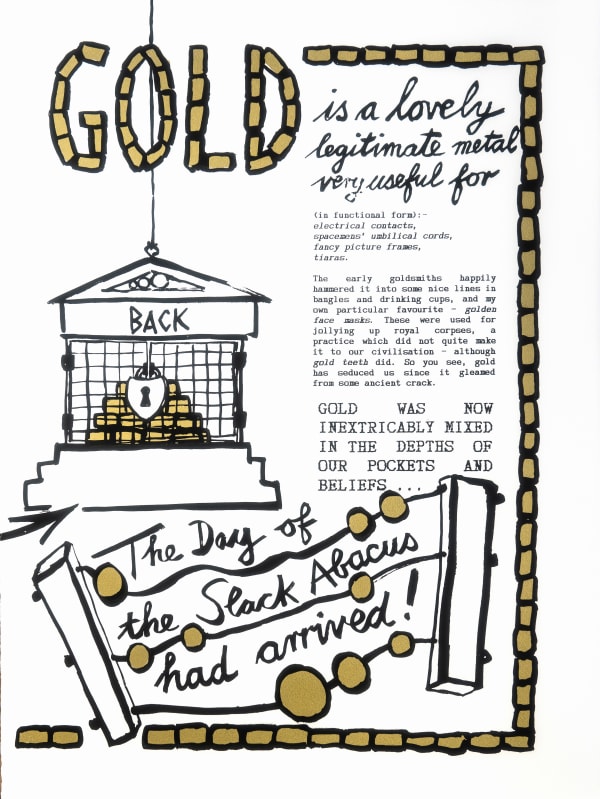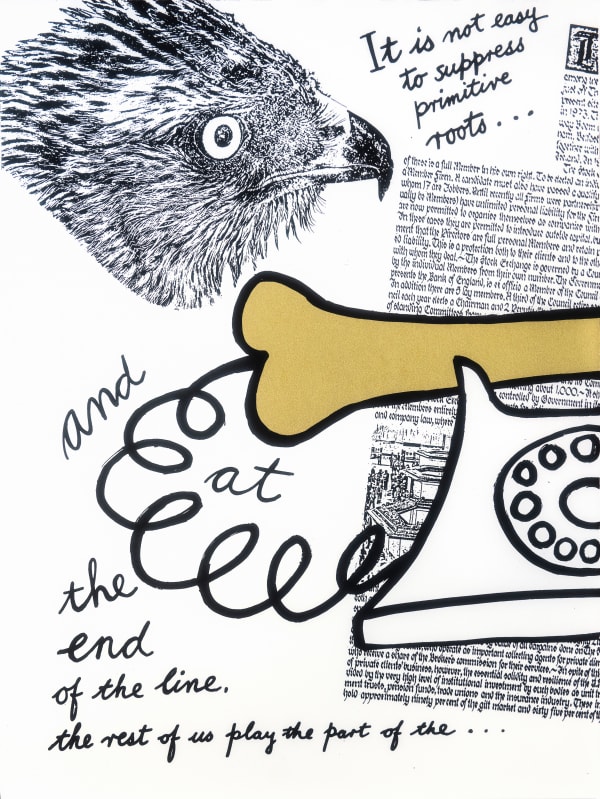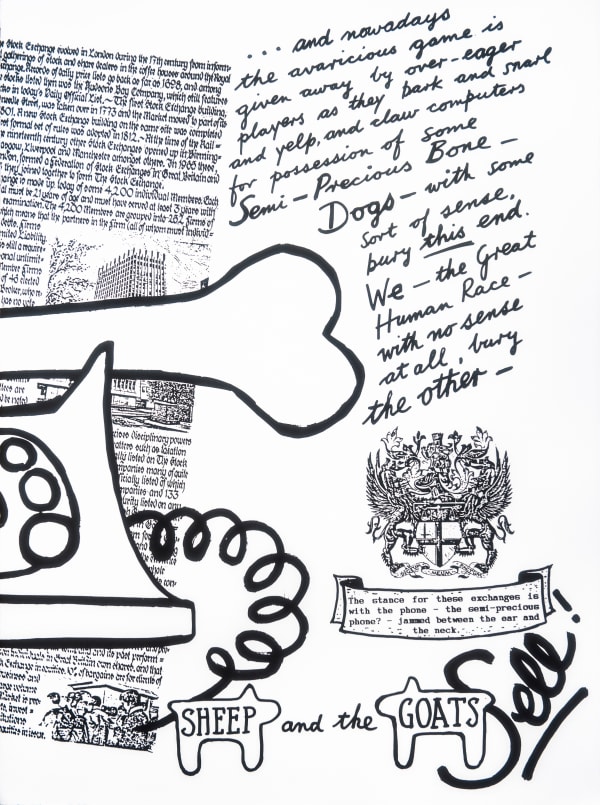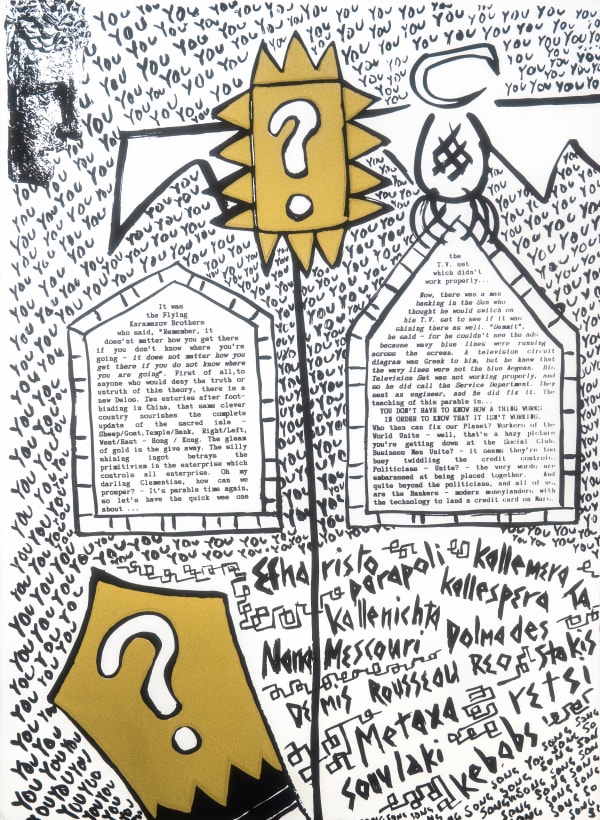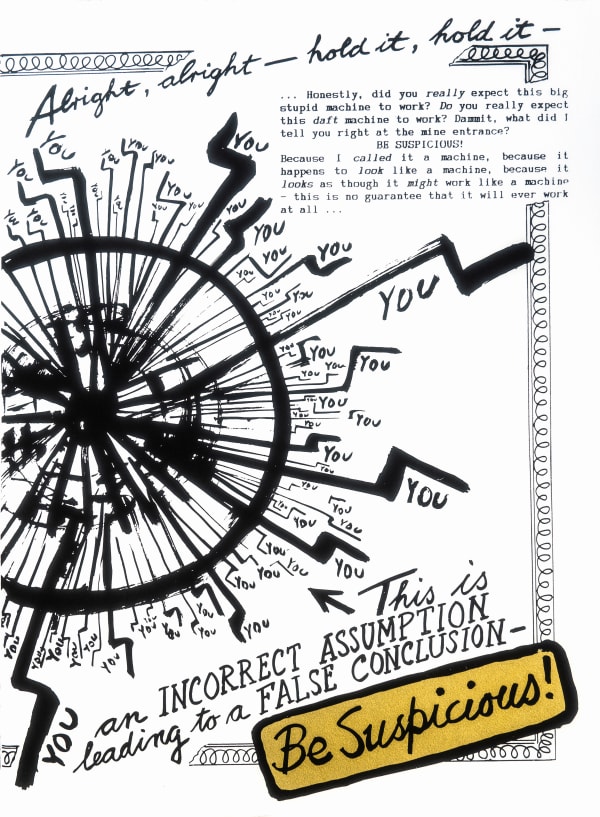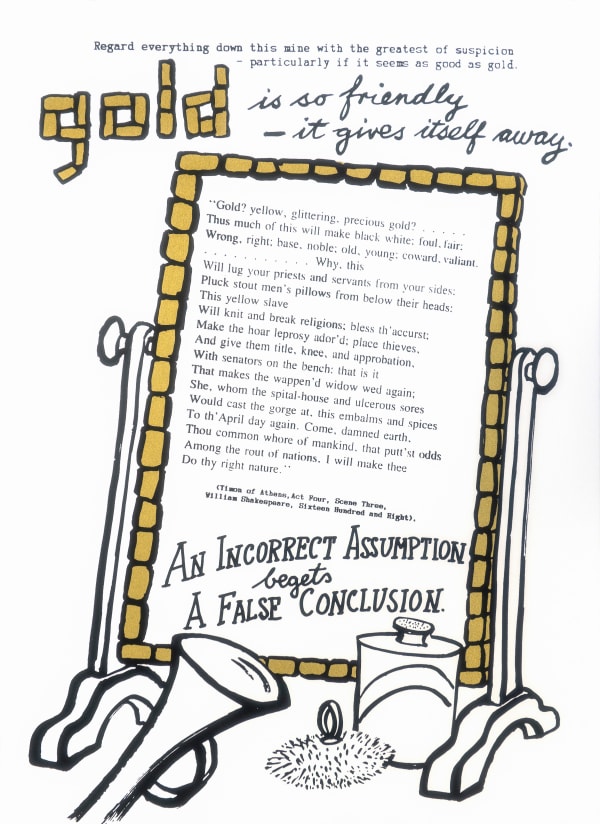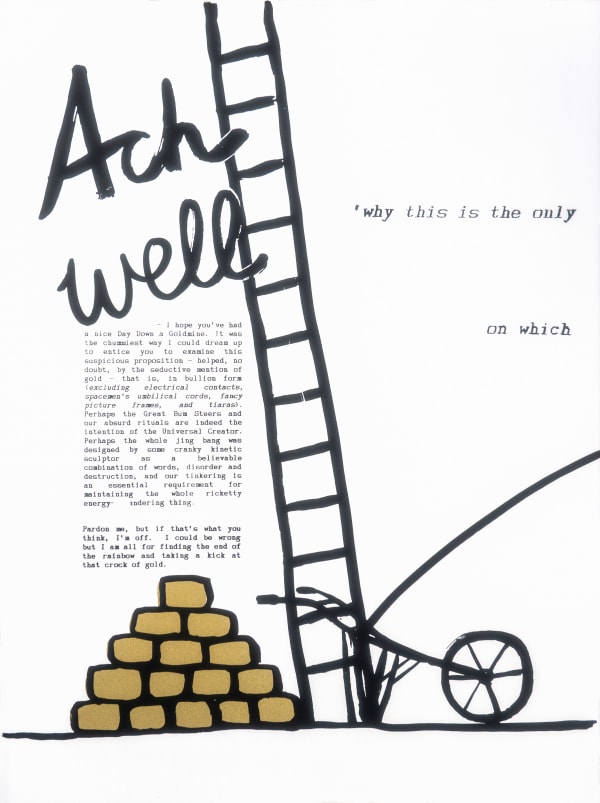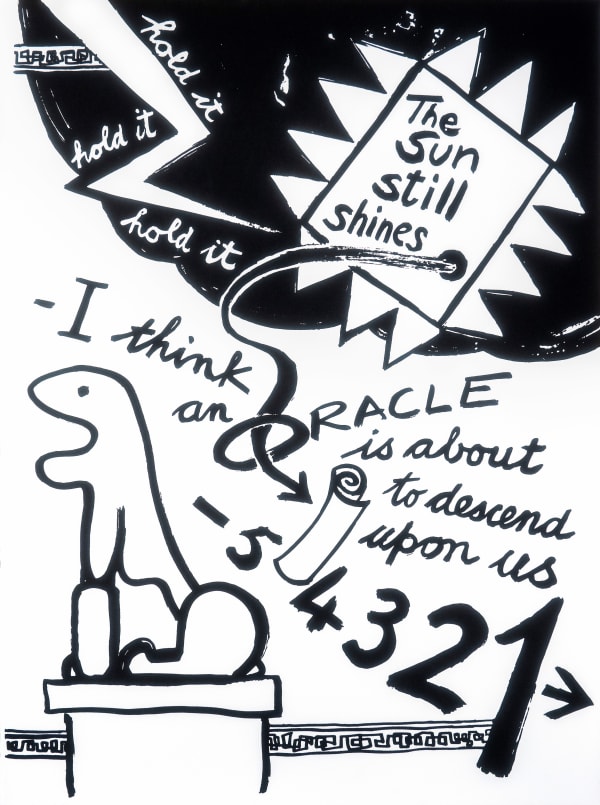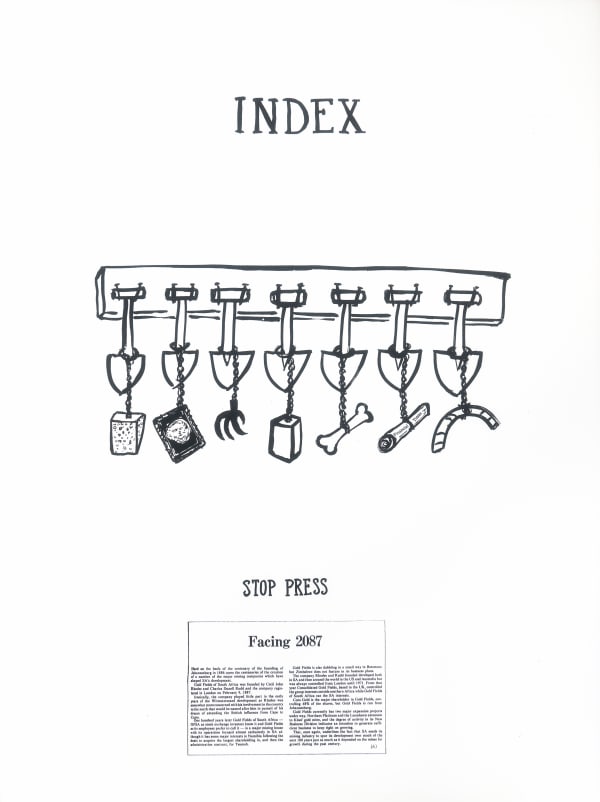Glasgow Print Studio is delighted to present A Day Down a Goldmine, an exhibition of rarely seen works on paper by the late George Wyllie (1921-2012).
A Day Down a Goldmine began as an installation consisting of "humorous sculpture with a deeply serious vein running through it" exhibited in 1982 at Glasgow's Third Eye Centre. Taking a leaf out of Joseph Beuys' book, and building on his own passion for performing, George had the idea of augmenting the exhibition with a theatrical experience.
First accompanied by Russell Hunter in 1982, it was performed again in 1984 with Bill Paterson at Watermans Art Centre, London and then went on to the Edinburgh Fringe Festival in 1985 where it won a Fringe First Award. A Day Down a Goldmine then toured venues across Scotland. The last performance was with John Bett at Tramway during Glasgow's reign as City of Culture in 1990.
A surreal satire of the world's banking systems, A Day Down a Goldmine's theme was mankind's never-ending pursuit of power through the accumulation of wealth, and it was George's first real attempt to counteract what he saw as an absurdity with another absurdity. "An incorrect assumption leads to a false conclusion" was the play's refrain. In other words, if we fool ourselves with minor absurdities, what happens when there are really major issues to deal with.
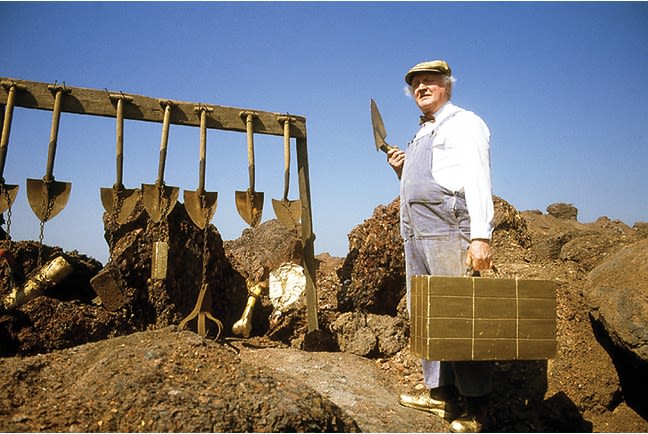
To accompany the performances, George produced a narrator's book featuring illustrations based on the sculptures and the lyrics to the accompanying songs and proclamations. The pages for the book were created as a series of exquisite prints, produced at Peacock Printmakers, Aberdeen, between 1987 and 1989. Now, after more than three decades, these original prints are being exhibited together and offered for sale for the first time at Glasgow Print Studio.
The prints remained in George's hands until they passed into the possession of his daughters, Louise and Elaine, at the time of his death in 2012. They have not been seen by the public as a body of work for 35 years. Thanks to the Estate of George Wyllie, they have now been made available publicly for the first time, as fresh as the day George made them all these years ago. Unseen and untouched, they are in limited numbers as first discovered.

Born in Glasgow on the 31st December 1921, George Ralston Wyllie was a performer and musician from an early age but for the majority of his adult life, he worked as a Customs and Excise officer in Ayrshire, Northern Ireland and Greenock. On leaving school, he trained as an engineer with the Post Office before serving with the Royal Navy, from 1942 to 1946. This included the experience of being of visiting the city of Hiroshima just a few months after it was devastated by an atomic bomb.
Throughout his working years George was a keen maker of objects, toy boats to seaworthy yachts, George took an art class in painting in the early 1960s, but he was more drawn to 3D objects and made his first sculpture in 1965 at the age of 44 years old. It was immediately obvious that this was his medium. In the late 1980s on taking early retirement he declared that it was "TIME FOR ART!"
He went on to use his makings to entertain, make philosophical statements, and question everything about the human condition including the world around us.

Celebrated for his commitment to art for everyone, Wyllie was a prolific maker, performer, and writer. He is perhaps best known for his ephemeral social sculptures which were often on a grand scale. His 75ft Paper Boat (1987), for example, brought a childlike sense of wonder to all who witnessed it whilst being a conceptual rallying call for a new creative economy. This and his Straw Locomotive (1987) are his most famous public art works, both of which strived to ask questions about the decline of heavy industry, particularly around Clydeside. Where, asked George, did all the creative energy go, which went into making all the great ships and engines?
For those unfamiliar with his temporary works, you can find two major public sculptures in Glasgow, The Running Clock at Buchanan Street Bus Station, and the Monument to Maternity at the University of Strathclyde in Rotten Row Gardens. He continued making art at his home overlooking the Firth of Clyde in Gourock until he was in his eighties. He died, aged 90, in 2012.
Understandably best known for his sculptural work, this exhibition at Glasgow Print Studio is an opportunity to explore other facets of his creative output.
Glasgow Print Studio would like to thank artist Willie Sutherland and George's daughter, Louise Wyllie, without whom this exhibition would not have been possible.
Photography courtesy of the George Wyllie Estate, David Atherton and Peacock Visual Arts.
-
 George Wyllie, A Day Down A Goldmine£ 1,000.00
George Wyllie, A Day Down A Goldmine£ 1,000.00 -
 George Wyllie, A Day Down A Goldmine 2£ 1,000.00
George Wyllie, A Day Down A Goldmine 2£ 1,000.00 -
 George Wyllie, A Day Down A Goldmine 3£ 1,000.00
George Wyllie, A Day Down A Goldmine 3£ 1,000.00 -
 George Wyllie, A Day Down A Goldmine 4£ 1,000.00
George Wyllie, A Day Down A Goldmine 4£ 1,000.00 -
 George Wyllie, A Day Down A Goldmine 5£ 1,000.00
George Wyllie, A Day Down A Goldmine 5£ 1,000.00 -
 George Wyllie, A Day Down A Goldmine 6£ 1,000.00
George Wyllie, A Day Down A Goldmine 6£ 1,000.00 -
 George Wyllie, A Day Down A Goldmine 7£ 1,000.00
George Wyllie, A Day Down A Goldmine 7£ 1,000.00 -
 George Wyllie, A Day Down A Goldmine 8£ 1,000.00
George Wyllie, A Day Down A Goldmine 8£ 1,000.00 -
 George Wyllie, A Day Down A Goldmine 9£ 1,000.00
George Wyllie, A Day Down A Goldmine 9£ 1,000.00 -
 George Wyllie, A Day Down A Goldmine 10£ 1,000.00
George Wyllie, A Day Down A Goldmine 10£ 1,000.00 -
 George Wyllie, A Day Down A Goldmine 11£ 1,000.00
George Wyllie, A Day Down A Goldmine 11£ 1,000.00 -
 George Wyllie, A Day Down A Goldmine 12£ 1,000.00
George Wyllie, A Day Down A Goldmine 12£ 1,000.00 -
 George Wyllie, A Day Down A Goldmine 13£ 1,000.00
George Wyllie, A Day Down A Goldmine 13£ 1,000.00 -
 George Wyllie, A Day Down A Goldmine 14£ 1,000.00
George Wyllie, A Day Down A Goldmine 14£ 1,000.00 -
 George Wyllie, A Day Down A Goldmine 15£ 1,000.00
George Wyllie, A Day Down A Goldmine 15£ 1,000.00 -
 George Wyllie, A Day Down A Goldmine 16£ 1,000.00
George Wyllie, A Day Down A Goldmine 16£ 1,000.00 -
 George Wyllie, A Day Down A Goldmine 17£ 1,000.00
George Wyllie, A Day Down A Goldmine 17£ 1,000.00 -
 George Wyllie, A Day Down A Goldmine 18£ 1,000.00
George Wyllie, A Day Down A Goldmine 18£ 1,000.00 -
 George Wyllie, A Day Down A Goldmine 19£ 1,000.00
George Wyllie, A Day Down A Goldmine 19£ 1,000.00 -
 George Wyllie, A Day Down A Goldmine 20£ 1,000.00
George Wyllie, A Day Down A Goldmine 20£ 1,000.00 -
 George Wyllie, A Day Down A Goldmine 21£ 1,000.00
George Wyllie, A Day Down A Goldmine 21£ 1,000.00 -
 George Wyllie, A Day Down A Goldmine 22£ 1,000.00
George Wyllie, A Day Down A Goldmine 22£ 1,000.00 -
 George Wylie, A Day Down A Goldmine 25
George Wylie, A Day Down A Goldmine 25 -
 George Wyllie, A Day Down A Goldmine 24£ 1,000.00
George Wyllie, A Day Down A Goldmine 24£ 1,000.00 -
 George Wyllie, A Day Down A Goldmine 25£ 1,000.00
George Wyllie, A Day Down A Goldmine 25£ 1,000.00 -
 George Wyllie, A Day Down A Goldmine 26£ 1,000.00
George Wyllie, A Day Down A Goldmine 26£ 1,000.00 -
 George Wyllie, A Day Down A Goldmine 27£ 1,000.00
George Wyllie, A Day Down A Goldmine 27£ 1,000.00 -
 George Wyllie, A Day Down A Goldmine 28£ 1,000.00
George Wyllie, A Day Down A Goldmine 28£ 1,000.00 -
 George Wyllie, A Day Down A Goldmine 29£ 1,000.00
George Wyllie, A Day Down A Goldmine 29£ 1,000.00 -
 George Wyllie, A Day Down A Goldmine 30£ 1,000.00
George Wyllie, A Day Down A Goldmine 30£ 1,000.00 -
 George Wyllie, A Day Down A Goldmine 31£ 1,000.00
George Wyllie, A Day Down A Goldmine 31£ 1,000.00 -
 George Wyllie, A Day Down A Goldmine 32£ 1,000.00
George Wyllie, A Day Down A Goldmine 32£ 1,000.00 -
 George Wyllie, A Day Down A Goldmine 33£ 1,000.00
George Wyllie, A Day Down A Goldmine 33£ 1,000.00 -
 George Wyllie, A Day Down A Goldmine 34£ 1,000.00
George Wyllie, A Day Down A Goldmine 34£ 1,000.00 -
 George Wyllie, A Day Down A Goldmine 35£ 1,000.00
George Wyllie, A Day Down A Goldmine 35£ 1,000.00 -
 George Wyllie, A Day Down A Goldmine 38£ 1,000.00
George Wyllie, A Day Down A Goldmine 38£ 1,000.00 -
 George Wyllie, A Day Down A Goldmine 39£ 1,000.00
George Wyllie, A Day Down A Goldmine 39£ 1,000.00 -
 George Wyllie, A Day Down A Goldmine 40£ 1,000.00
George Wyllie, A Day Down A Goldmine 40£ 1,000.00



